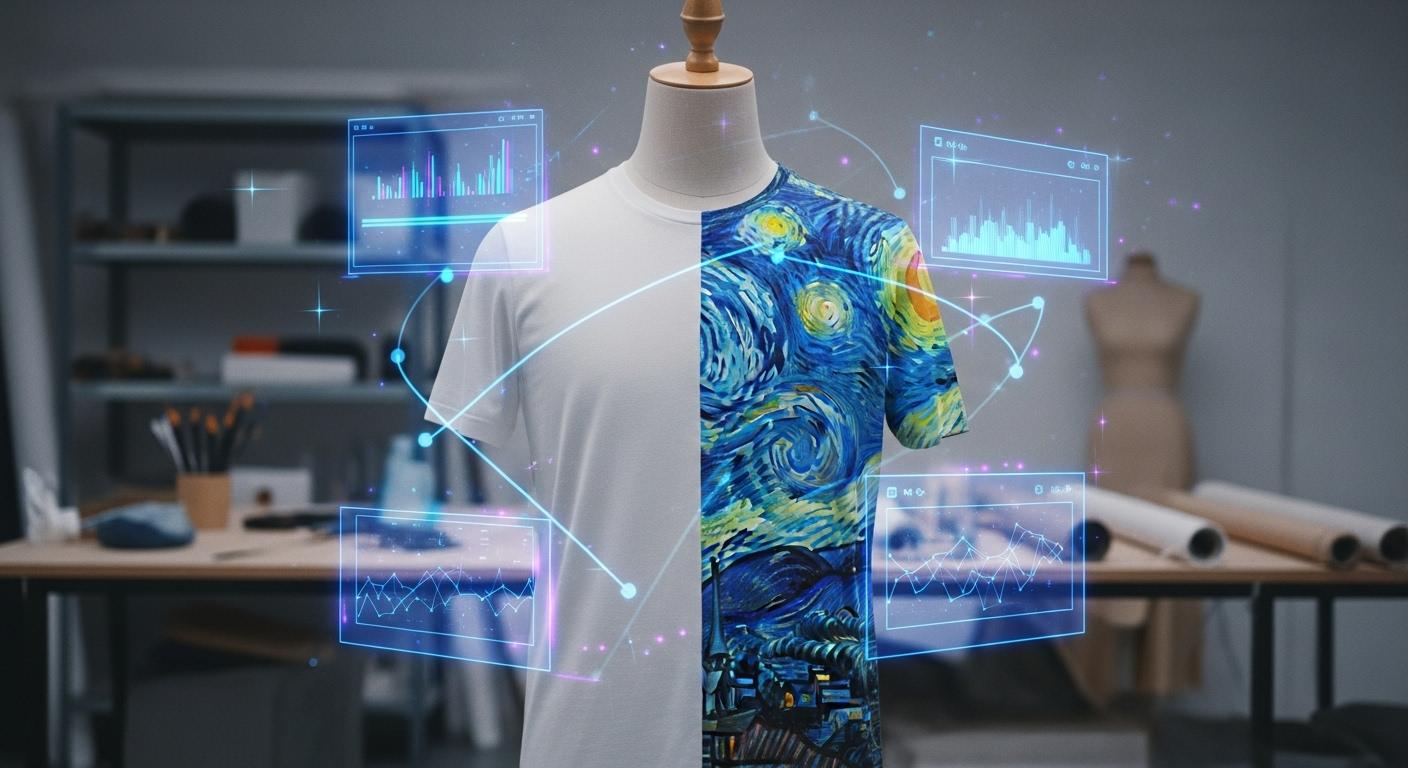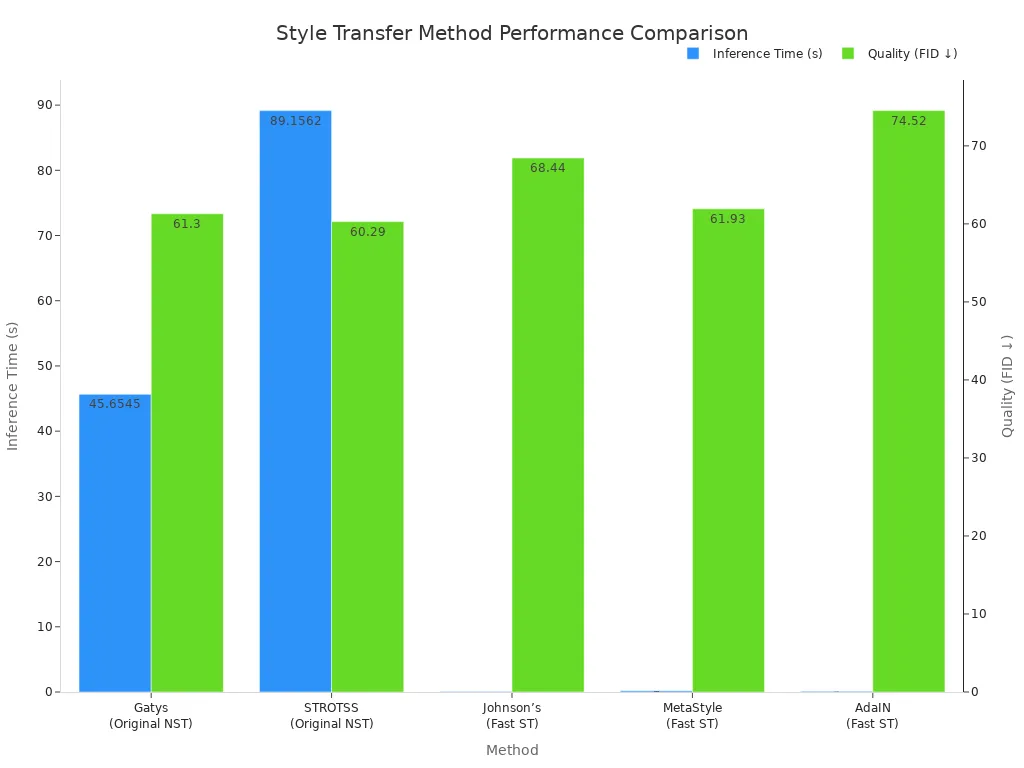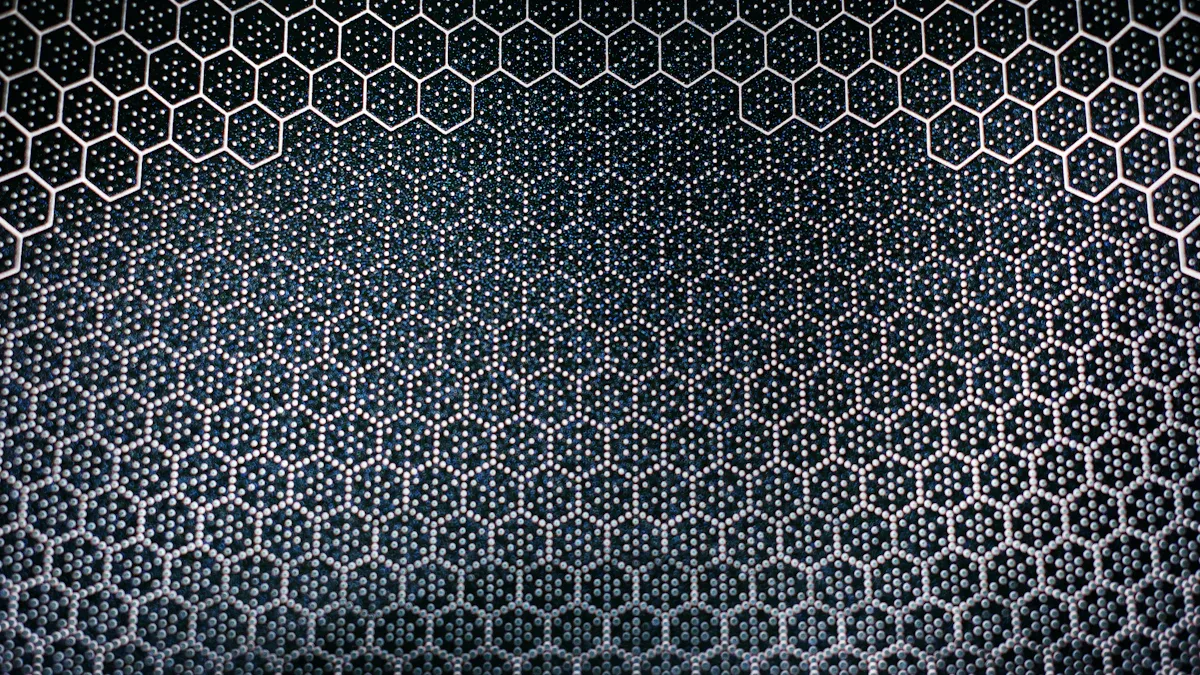
Style transfer techniques create an artistic fusion of fashion and culture. Neural networks learn the artistic style from cultural heritage. The networks then apply this cultural style, including unique patterns and motifs, to a garment's design. This process results in a new, synthesized image. The apparel shows a beautiful fusion of its original form and the artistic style of the cultural heritage. This artistic fusion in design is a key reason 73% of fashion executives now prioritize generative AI, a technology set to add over $150 billion to the sector. This fusion represents a powerful artistic style fusion. This cultural fusion creates new patterns and a unique style fusion.
Understanding Style Transfer Techniques

AI offers several methods for merging cultural motifs with apparel. These style transfer techniques use deep learning models to analyze and combine images. Each method provides unique advantages for fashion designers. Understanding them helps designers choose the right tool for their creative vision.
Neural Style Transfer (NST)
Neural Style Transfer (NST) is the foundational method that started this creative revolution. It uses a deep learning model to separate an image's content from its style. The content is the core structure of an object, like the shape of a t-shirt. The style includes features like colors, textures, and artistic patterns. The model then applies the style of one image (a cultural motif) to the content of another (a garment).
The core process relies on a pre-trained deep learning network, often VGG19. This network processes the garment image, the motif image, and the new output image.
- Content Extraction: Deeper layers of the network capture high-level content information. This ensures the final design retains the garment's original shape.
- Style Extraction: Shallower layers extract low-level features like textures and patterns from the motif. The model analyzes these features to understand the artistic style.
- Image Synthesis: The algorithm iteratively adjusts the output image. It minimizes the difference between its content and the garment's content. It also minimizes the difference between its style and the motif's style. This deep learning process creates a new image where the apparel adopts the beautiful patterns of the motif.
Did You Know? The groundbreaking paper "A Neural Algorithm of Artistic Style" by Leon Gatys and his colleagues introduced this concept. It laid the groundwork for using deep learning in artistic creation.
Frameworks like PyTorch and Keras provide the tools for developers to implement these deep learning models. They allow designers to experiment with different patterns and create unique apparel designs.
Fast Style Transfer for Real-Time Design
Original NST is powerful but slow. It requires a lengthy optimization process for every new design. Fast style transfer solves this problem. It uses a pre-trained deep learning network that applies a specific style in a single step. This makes fast style transfer ideal for real-time applications where speed is essential. Designers can instantly see how different patterns look on a garment.
However, speed comes with a trade-off. While fast style transfer is incredibly efficient, original NST methods often produce higher-quality results. The iterative process of NST allows for a more detailed and realistic fusion of content and style. The table and chart below compare the performance of different methods.
| Method | Inference Time (s) | Quality (FID ↓) |
|---|---|---|
| Gatys (Original NST) | 45.6545 | 61.30 |
| STROTSS (Original NST) | 89.1562 | 60.29 |
| Johnson’s (Fast ST) | 0.0881 | 68.44 |
| MetaStyle (Fast ST) | 0.1868 | 61.93 |
| AdaIN (Fast ST) | 0.1083 | 74.52 |

Qualitative results show that original NST often generates images that appear more realistic. The fast style transfer methods are perfect for quick prototyping and interactive design tools. For example, platforms like Shakker AI use fast style transfer to help designers apply artistic patterns to fabrics in real time, even on video. This technology helps create unique patterns and modern textile designs quickly.
Universal and Adaptive Methods
Early fast style transfer methods had a major limitation. Each model could only learn one specific style. A designer wanting ten different patterns would need ten separate models. Universal and adaptive methods solve this issue, offering the best of both worlds: speed and flexibility.
A key innovation here is Adaptive Instance Normalization (AdaIN). This deep learning technique allows a single model to apply any new style without retraining.
- AdaIN works by analyzing the statistical properties (mean and variance) of the style image's features.
- It then adjusts the content image's features to match these properties.
- This process dynamically transfers the new style, including its unique patterns, onto the garment.
This approach is a significant improvement for apparel design. Earlier style transfer techniques were not designed for fashion. They often distorted the garment's shape or failed to preserve fabric textures. Newer adaptive deep learning models, like modified versions of StarGANv2, are built for fashion. They can generate diverse patterns and colors while keeping the source garment's content and texture intact. This deep learning approach enables a more seamless and authentic fusion of style and apparel, allowing for endless creative patterns. These advanced style transfer techniques give designers the power to explore any artistic style on any garment.
A Guide to Design Integration

Successful style integration transforms a concept into a wearable piece of art. This guide provides a practical walkthrough for designers. It covers the entire process from selecting images to preparing the final design for production. Following these steps helps ensure a smooth and creative design integration workflow.
Selecting Images and Motifs
The quality of the final design begins with the quality of the input images. Designers must choose a high-resolution content image of the apparel. This ensures the garment’s shape and structure remain clear. Equally important is the style image. A powerful cultural motif carries deep meaning and aesthetic value. An effective style image for a style transfer algorithm has specific qualities.
- It accurately captures artistic features, color systems, and pattern structures.
- It preserves pattern continuity across complex fabric folds.
- It allows for the integration of cultural insights through the clothing's patterns, colors, and texture.
- It carries semantic information and profound cultural connotations.
- It enables multi-layered compositions through flexible combinations.
Choosing a motif with these characteristics provides the style transfer algorithm with rich information. This leads to a more authentic and visually compelling pattern design. The goal is a beautiful style integration, not just a simple texture swap.
Choosing the Right Tools
Designers have access to a wide range of tools for apparel design. The choice depends on technical skill and project goals.
- No-Code Platforms: Services like RunwayML or Artbreeder offer user-friendly interfaces. Designers can upload images and apply a style with a few clicks. These platforms are excellent for rapid experimentation and concept development.
- Code-Based Libraries: For maximum control, developers and technical designers can use libraries like PyTorch or TensorFlow. These tools allow for deep customization of the style transfer algorithm. This path requires programming knowledge but offers unlimited creative freedom.
Each tool facilitates the integration of art into fashion. They empower designers to explore new patterns and create a unique design.
The Core Style Transfer Algorithm
The heart of the creative process lies within the style transfer algorithm. Designers can adjust several parameters to influence the final output. The most critical parameter is the 'style weight'. This setting controls the balance between the garment's structure and the motif's style.
Adjusting the 'style weight' directly influences the intensity of the artistic style. A higher style weight makes the cultural patterns more prominent in the final design. A lower style weight preserves more of the original garment's content and texture. This trade-off is central to the style transfer algorithm. Experimenting with this weight allows for diverse and unique results. This control in the style transfer algorithm is key to generating novel clothing designs. A designer can use the style transfer algorithm to transform conventional patterns into new, stylish apparel. The style transfer algorithm offers a powerful way to direct the aesthetic outcome of the pattern design. This careful adjustment of the style transfer algorithm is essential for a successful pattern design.
Designer's Tip: Start with a balanced weight and create several versions. Compare how different settings affect the visibility of the patterns and the clarity of the garment's silhouette. This iterative process is key to finding the perfect style.
Refining for Production
The output from a style transfer algorithm is a creative starting point, not a finished product. Post-processing is a crucial step for preparing the design for fabric printing. Professional editing software provides the necessary tools for this refinement.
The integration of AI tools like Adobe Firefly with Photoshop offers powerful post-processing capabilities. Designers can use these tools to make minor adjustments to color balance or contrast. These small changes can significantly improve the final pattern design without losing its core character. For large-scale printing, a tool like a Pattern Upscaler can enhance the resolution of the generated patterns. This ensures the design remains crisp and clear on the final fabric. This final integration of human expertise and AI output is what makes a digital concept ready for the physical world. This step completes the pattern design process, ensuring the style is ready for manufacturing.
Challenges and Cultural Ethics
While style transfer offers exciting creative avenues, designers face significant technical and ethical challenges. Success requires navigating these issues thoughtfully to ensure both high-quality design and respectful cultural engagement.
Technical Hurdles in Apparel
Applying digital styles to apparel presents unique technical problems. Current methods often struggle to preserve the texture details of traditional patterns. They have difficulty representing patterns faithfully and disentangling garment distortions. This can cause a major loss in the continuity and quality of the cultural heritage patterns, affecting the final design authenticity. The preservation of these details is key.
Pattern Distortion on 3D Forms
Transferring a 2D style onto a 3D garment often distorts the traditional patterns. New methods offer solutions for better preservation.
- One approach uses a scale-preserving method to adjust 2D sewing
patterns. It helps maintain the original shapes of thetraditionalpatterns. - Another technique uses graphic coding to map the relationship between 2D
patternsand the 3D garment. This allows for the direct generation oftraditionalpatternson the 3D form, ensuring betterdesign authenticity. Thepreservationofurban cultural heritagepatternsis a goal.
The Ethics of Cultural Motifs
Using cultural motifs without understanding their cultural context can lead to appropriation. For example, Dolce & Gabbana faced criticism for trivializing Chinese culture. Gucci also pulled a product that resembled blackface. These events show the danger of removing ethnic cultural patterns from their heritage. Such actions can damage a brand and disrespect a community's identity and cultural heritage. The preservation of cultural identity is vital. This includes the preservation of urban cultural heritage and its traditional cultural patterns.
Collaboration Over Appropriation
The ethical path forward is collaboration, not appropriation. This approach respects cultural heritage and promotes authenticity. Designers can follow the "3Cs" Rule: Consent, Credit, and Compensation. This ensures fair partnerships with artisans.
A Mexican designer, for instance, created a mobile
designlab to co-create with local artisans. This model gives full acknowledgment to the community'sheritageandidentity.
This method supports the preservation of traditional cultural heritage and urban cultural heritage. It builds a bridge between modern design and traditional heritage, ensuring the authenticity of ethnic cultural patterns. This respectful engagement with cultural heritage and urban cultural heritage is essential for the cultural industry. It protects traditional cultural heritage and its ethnic cultural patterns. This is the future of cultural heritage in fashion.
The Future of AI in Fashion
The future of fashion design is evolving rapidly with artificial intelligence. New AI technologies are moving beyond simple style transfer. They offer powerful tools for creation, sustainability, and personalization. These advancements promise to reshape the entire industry.
Generative Adversarial Networks (GANs)
Generative Adversarial Networks (GANs) represent a major leap in AI creativity. This deep learning technology uses two neural networks. One network generates new images, while the other evaluates them. This process creates highly realistic and novel clothing patterns. This technology supports ethnic pattern innovation.
- The Fabricant creates entirely digital couture using AI tools.
- Maison Meta launched the first AI Fashion Week, showcasing collections made with AI.
These examples show how deep learning can produce unique patterns and drive new design trends.
3D Style Transfer Models
AI is now moving from 2D images to realistic 3D models. New AI dress generators simulate fabric properties like texture, weight, and flow. This deep learning approach allows virtual garments to drape and move naturally on avatars. AI systems like AIpparel can even generate simulation-ready sewing patterns from a simple text prompt. This allows for better ethnic pattern innovation and creates more realistic digital patterns.
Impact on Sustainable Prototyping
AI-powered virtual sampling significantly reduces waste. Designers create "digital twins" of garments. These virtual prototypes show how patterns will look and move. This process eliminates the need for many physical samples.
Companies like Perry Ellis have reduced physical samples by 50%. They achieve a 95% first-time-right fit rate with digital versions. This sustainable style saves fabric, water, and shipping emissions. This approach to ethnic pattern innovation is also more efficient.
The Rise of Hyper-Personalization
AI enables a new level of personalized fashion. It allows customers to become co-creators of their own style. Platforms like Cala use AI to turn customer ideas into real clothing patterns. This deep learning method can even create multi-layered ethnic pattern compositions. Brands like Adidas and Tommy Hilfiger use AI to analyze trends and offer personalized products. This focus on ethnic pattern innovation gives consumers a unique voice in their clothing style. AI helps create unique patterns for every customer.
Style transfer techniques unlock new creativity. They merge apparel design with cultural heritage, cultural heritage, and cultural heritage. Designers must respect cultural heritage. This cultural responsibility protects cultural heritage and the cultural heritage of communities. Thoughtful style transfer techniques can connect global fashion. They honor cultural heritage, cultural heritage, cultural heritage, and cultural heritage.
This approach fosters a more diverse and connected cultural landscape.
FAQ
What is the main difference between fast and original style transfer?
Original Neural Style Transfer (NST) creates higher-quality images but is very slow. Fast style transfer methods generate designs almost instantly. Designers choose a method based on their project's need for either top quality or rapid prototyping.
Can designers use style transfer without coding?
Yes, designers can use AI without programming skills. 💻
No-code platforms like RunwayML or Artbreeder provide simple interfaces. Users upload a garment image and a style image. The platform then merges them with just a few clicks, making the technology very accessible.
Why is post-processing important for apparel design?
An AI-generated image is a creative first draft. Designers must refine it for production. They use editing software to adjust colors and improve resolution. This step ensures the final pattern looks sharp and professional when printed on fabric.
How can designers use cultural motifs ethically?
Designers should collaborate directly with cultural artisans and communities. Following the "3Cs" rule (Consent, Credit, and Compensation) ensures a respectful partnership. This approach honors heritage and creates authentic, meaningful fashion designs.
See Also
Apparel's Evolution: From Manufacturing to Branding Through Strategic Transformation
Balancing Fashion's Flow: Predictive Analytics for Supply and Demand
Fashion Retail's Future: Predictive Models Shaping 2025 Trends
Machine Learning's Role: Predicting Fashion Trends and Driving Sales Growth
AI's Agility: Managing Viral Trends in the Fast Fashion Industry